
Kalmia is a genus of about ten species of evergreen shrubs from 0.2–5 m tall, in the family Ericaceae. They are native to North America and Cuba. They grow in acidic soils, with different species in wet acid bog habitats and dry, sandy soils.

Crassula tetragona is a succulent plant native to Southern Africa. It is widely distributed from the Orange River boundary of Namaqualand to beyond the Kei River in the Eastern Cape. "Tetragona" comes from the phyllotaxy of the leaves. It is popularly named the "miniature pine tree" among ornamental plant enthusiasts, for its popular use as a "pine tree" in Bonsai.

Cotyledon tomentosa is a species of flowering plant in the family Crassulaceae, native to South Africa. It is a succulent evergreen shrub with large chunky ovate fuzzy green leaves. Its autonymous subspecies is known as the bear's paw because of the prominent "teeth" at the tips of its leaves. It forms large orange bell-shaped flowers in spring. In its native habitat, the Little Karoo region of South Africa, Cotyledons usually grow in rocky quartz fields where they have excellent drainage provided by very porous soil.

Crassula arborescens, the silver jade plant, silver dollar plant, beestebul, Chinese jade, money plant, or money tree, is a species of succulent plant in the family Crassulaceae. It is an endemic plant of the Western Cape, South Africa. It is a 2 to 4 ft succulent shrub. It has round gray "Silver Dollar" leaves. It blooms in summer, with white to pink flowers. It is cultivated as an ornamental plant for use in drought tolerant and succulent gardens, and in container gardens. It is also suitable for growing indoors as a houseplant.
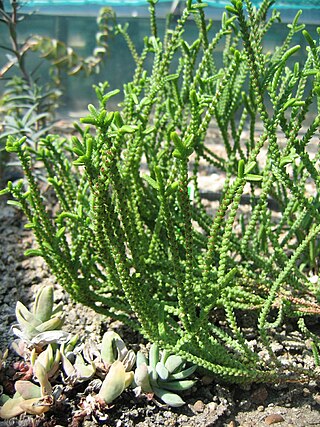
Crassula muscosa, synonyms Crassula lycopodioides and Crassula pseudolycopodioides, is a succulent plant native to South Africa and Namibia, belonging to the family of Crassulaceae and to the genus Crassula. It is a houseplant grown worldwide and commonly known as rattail crassula, watch chain, lizard's tail, zipper plant and princess pines.
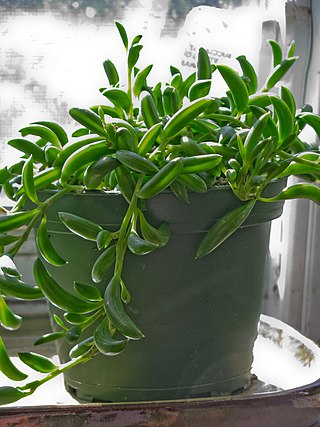
Curio radicans, syn. Senecio radicans, is a succulent houseplant that is native to Southern Africa. A member of the family Asteraceae, the asters, this species is closely related to the common string of pearls and Curio hallianus. It has multiple tendrils of glossy, banana-shaped foliage. It is commonly known as string of bananas or fishhook senecio.

Crassula marnierana, common name Jade Necklace or Chinese Pagoda, is a species of succulent flowering plant in the family Crassulaceae.

Crassula capitella, is a perennial succulent plant native to southern Africa.

Crassula ovata, commonly known as jade plant, lucky plant, money plant or money tree, is a succulent plant with small pink or white flowers that is native to the KwaZulu-Natal and Eastern Cape provinces of South Africa, and Mozambique; it is common as a houseplant worldwide. Much of its popularity stems from the low levels of care needed; the jade plant requires little water and can survive in most indoor conditions. It is sometimes referred to as the money tree; however, Pachira aquatica also has this nickname.
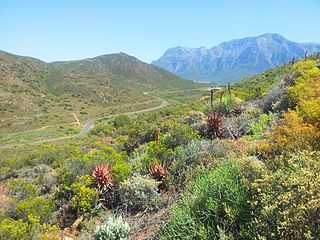
Robertson Karoo is a semi-arid vegetation type, restricted to sections of the Breede River Valley, Western Cape Province, South Africa. It is a subtype of Succulent Karoo and is characterised by the dominance of succulent plant species, and by several endemic plants and animals.

Crassula nudicaulis is a succulent plant native to South Africa, and Lesotho.

Crassula brevifolia is a succulent plant native to the arid western edge of South Africa as well as southern Namibia.
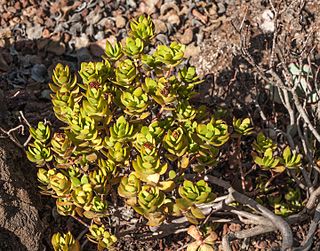
Crassula cultrata is a succulent plant native to the southern parts of South Africa.

Crassula rubricaulis is a succulent plant native to the coastal mountains of the Eastern Cape and Western Cape of South Africa.

Crassula pellucida is a creeping, succulent ground-cover, or low-growing, spreading succulent shrub. It is native to eastern and southern Africa, ranging from Kenya and Angola to South Africa.

Crassula biplanata is a succulent plant native to rocky ledges and mountainous areas in the southern parts of South Africa.
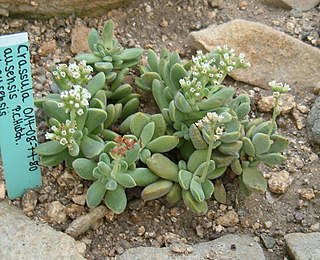
Crassula ausensis is a species of succulent in the genus Crassula found in Namibia. Crassula ausensis subsp. giessii and Crassula ausensis subsp. titanopsis are varieties of the species.
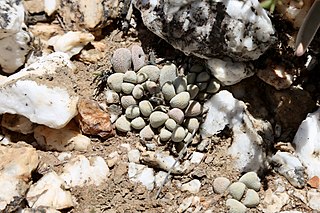
Crassula tecta is a species of succulent plant in the genus Crassula native to South Africa. Easily confused with Crassula namaquensis, this species has a compact growth habit forming clusters of round, blue-white leaves. Kept in cultivation since the 18th century, Crassula tecta is known for the beautiful patterning on its leaves and white flowers.
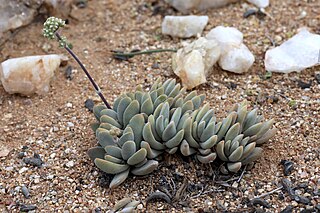
Crassula namaquensis is a species of succulent plant in the genus Crassula native to South Africa. Easily confused with some forms of Crassula tecta and Crassula sericea, this species has rounded to elongated leaves that are usually blue, covered in fine hairs, and form clumps.



















